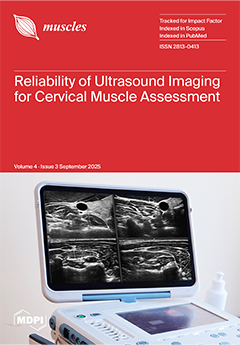Chronic musculoskeletal pain negatively affects patients’ quality of life, and pain perceptions may significantly influence rehabilitation outcomes. This study investigated the relationships among pain intensity, pain perceptions, and kinesiophobia in individuals with chronic musculoskeletal pain. No previous studies have examined these variables in
[...] Read more.
Chronic musculoskeletal pain negatively affects patients’ quality of life, and pain perceptions may significantly influence rehabilitation outcomes. This study investigated the relationships among pain intensity, pain perceptions, and kinesiophobia in individuals with chronic musculoskeletal pain. No previous studies have examined these variables in combination. A cross-sectional observational study was conducted with 37 participants with non-specific chronic musculoskeletal pain for at least 6 months, affecting the neck (n = 8), lower back (n = 18), upper limbs (n = 5), lower limbs (n = 5), or shoulder (n = 1). The following validated tools were used: (a) Pain Beliefs and Perceptions Inventory (PBPI), (b) the Tampa Scale for Kinesiophobia (TSK), and (c) the Short-Form McGill Pain Questionnaire (SF-MPQ). Spearman r correlation analyses were performed. Total kinesiophobia scores were positively correlated with (a) total pain intensity (McGill score) (r = 0.37,
p = 0.022), (b) present pain intensity (PPI) (r = 0.52,
p = 0.001), (c) pain duration (r = 0.51,
p = 0.001), (d) the “mystery” factor of pain perception (r = 0.41,
p = 0.013), and (e) the Visual Analogue Scale (VAS) (r = 0.42,
p = 0.009). The total pain perception scores were positively associated with the “fear of injury” factor of kinesiophobia (r = 0.36,
p = 0.028). The McGill pain scores were strongly correlated with both PPI (r = 0.63,
p = 0.001) and VAS (r = 0.51,
p = 0.001). There is a significant relationship between pain perception and kinesiophobia levels in patients with chronic musculoskeletal pain. Limitations of the study include a small and heterogeneous sample regarding pain localization. Further research is required using larger, more homogeneous populations to confirm the present findings.
Full article






